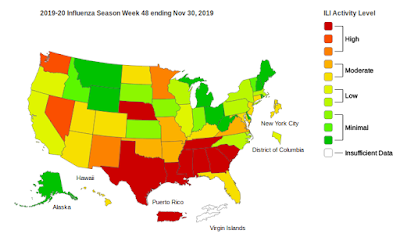#14,566
Today's CDC FluView reports shows that the 2019-2020 flu season is now well underway across most of the nation, and that unusually, influenza B is leading the pack, followed by H1N1 and then H3N2.
Influenza B activity most often surges in late spring, as the winter Influenza A epidemic subsides, although we've recently seen several countries report influenza B dominated flu seasons (see Denmark's Flu 2017-18 Season: Attack of The Killer B's and in China for much of the 2017-2018 flu season.Despite a long-standing reputation as being `less serious' than influenza A, recent studies have shown little difference in their respective severity (see Influenza B: A Virus Not To Be Underestimated).
A study published in early 2018 - NEJM: Acute Myocardial Infarction After Laboratory-Confirmed Influenza Infection- found that Influenza B (rather than A) that produced the highest coronary risk, at least among their limited sample size (n=364).Dominant flu strains often shift dramatically over the course of a single flu season, and while influenza B is currently king of the viral mountain, there is plenty of time for either H1N1 or H3N2 to make a bid for the lead.
Interestingly, clade 3C.3a H3N2 viruses which took over the second half of last year's U.S. flu season - and prompted a delayed decision on this year's flu vaccine (see WHO Selects Fall H3N2 Flu Shot Component: Clade 3C.3a) - has yet to turn up in this year's CDC testing.
Some excerpts from today's FluView report include:
Key Updates for Week 48, ending November 30, 2019Seasonal influenza activity in the United States has been elevated for four weeks and continues to increase.
Key Points
- The 2019-2020 flu season is underway for most of the country, however some parts of the country are still seeing lower levels of flu activity.
- Activity is being caused mostly by influenza B/Victoria viruses, which is unusual for this time of year. H1N1 viruses are the next most common, followed by H3N2 viruses, which are decreasing in proportion.
- The flu season is just getting started; elevated flu activity is expected to continue for weeks. It’s not too late to get vaccinated. Flu vaccination is the best way to reduce the risk from flu and its potentially serious complications.
Nationally, influenza B/Victoria viruses are the most commonly reported influenza viruses among children age 0-4 years (46% of reported viruses) and 5-24 years (60% of reported viruses), while A(H3N2) viruses are the most commonly reported influenza viruses among persons 65 years of age and older (54% of reported viruses). Among adults aged 25-64 years, approximately equal proportions of influenza A(H1N1)pdm09 and B/Victoria viruses (35% and 34%, respectively) have been reported. Additional age data can be found on FluView Interactive.
Nationwide during week 48, 3.5% of patient visits reported through the U.S. Outpatient Influenza-like Illness Surveillance Network (ILINet) were due to influenza-like illness (ILI). This percentage is above the national baseline of 2.4%.
(Continue . . . )
It is not too late to get a flu shot, and if you do get sick, call your doctor. Early treatment with antivirals can shorten your illness, and for some patients, can be life saving.
Now is also the time to rigorously practice good flu hygiene. Stay home if you are sick, avoid crowds, wash your hands frequently, and cover your coughs and sneezes.While this year's flu season has arrived several weeks earlier than usual, there is no way of knowing how long this year's flu season will last. Safe to say, however, there's probably at least a couple of months flu activity still ahead.



